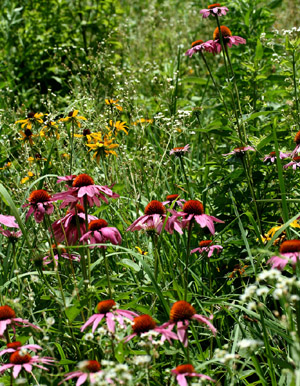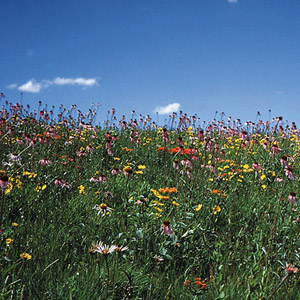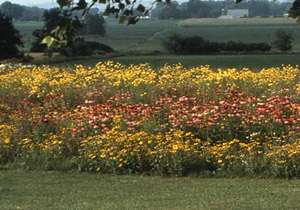My Cart: 0 item(s)
Designing Your Meadow
There are two types of meadows: tallgrass and shortgrass. Prior to widespread utilization of the steel plow, which enabled people to convert the land to agricultural use, tallgrass meadows once covered the mid-continent from central Kansas east into Ontario, from Texas north to Manitoba. They flourished in areas with rich soils and moderate rainfall of around 30 to 35 inches (760 to 890 mm) per year. Shortgrass meadows occurred where rainfall was less frequent and the soils were less fertile. Re-creating natural meadows is what conservationists refer to as a "restoration". In natural meadows, the proportion of wildflowers to native grasses heavily favours the grasses. While these natural meadows are beautiful just as they are; often people tend to see these "restoration meadows" as messy. We want more flowers! At Wildflower Farm, we use the ecological principles found in nature to create diverse plant communities that are compatible with nature's processes for sustaining life. At the same time, we design our seed mixes incorporating much higher percentages of wildflowers. This works to be the best of both worlds: our meadows are sustainable and provide food and habitat for a wide variety of pollinators, insects, birds and small mammals while providing you with more flowers! Tallgrass Meadows
Tallgrass meadows are best suited to large spaces or as background plantings. Some of the plants in a tallgrass meadow can grow up to eight feet or more and, if planted in front of shorter plants, can cast unwanted shade over plants that require sun. If you are designing your meadow to be seen, keep in mind that tall plants will hide shorter ones. Shortgrass Meadows
Shortgrass meadows work well around homes or other buildings, keeping in mind the sun requirements for the plants. The plants in shortgrass meadows also work well at the front of a large meadow if you are designing the space for visual effect. Combining Meadow Types You may want to plant some areas of both tall and short meadow to create two different landscape effects and habitat types. Combining tall and shortgrass meadows can create a layered effect and, if done properly, can bring in beauty and an abundance of wildlife. Keep your tallgrass meadow at the back and your shortgrass meadow at the front so all species may be seen from your viewing area. Remember that if you plant a tallgrass meadow to the west or north of your shortgrass meadow, seeds from taller plants may blow into the shortgrass meadow planting to the east and south. If this happens, over time your shortgrass meadow will become a tallgrass meadow. No matter what type of meadow you choose to sow it's a good idea to include trails and pathways through your meadow so you can enjoy its different moods and intricacies up close. Our low maintenance Eco-Lawn grass seed is ideal for these trails and pathways. Avoid Mono-Culture Plantings Planted and growing alone, most species do not have sufficiently thick root systems to squeeze out weeds by themselves and they can't out-compete weeds for essential nutrients, light and water. By sowing native grasses and wildflowers together the complementary root systems of the wildflowers and grasses will work to squeeze out weeds. The inclusion of a wide variety of native flowers and grasses is nature's secret to creating low-maintenance meadows that require no chemical inputs and are significantly less work than the typical flower bed filled with non-native or single species plants. Why not let the plants do the hard work for us?
Swaths For an extra floriferous show of bold colours, it's a great idea to create swaths of flowers in your meadow. To do this, first sow the meadow mix of your choice and then over-seed large swaths with individual flowers such as Pale Purple Coneflower, Butterflyweed or any other wildflower you like (be sure to select species that will grow well in your soil type). When your meadow is mature, you'll get to enjoy these bold colour statements and the diverse variety of wildflowers and grasses in your meadow will ensure that there are no "empty" areas when the flowers in your swaths have gone to seed. Design with Maintenance in Mind Whether your long-term plan for your meadow's maintenance involves mowing or controlled burns, the time to plan for this maintenance is now - before you sow the seed. We recommend using our low maintenance Eco-Lawn grass seed to create pathways that divide your meadow into two or three "management units". It's also a good idea to surround your meadow with Eco-Lawn or, at the very least, plan to keep mowed pathways within your meadow and a mowed buffer zone of at least 10 feet (3 meters) wide surrounding the area. Procedures for long-term management of your meadow are detailed on our "Long-Term Management" page. |



